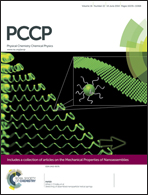Rate constants for collisional quenching of NO (A2Σ+, v = 0) by He, Ne, Ar, Kr, and Xe, and infrared emission accompanying rare gas and impurity quenching
Abstract
The quenching rates of NO (A2Σ+, v = 0) with He, Ne, Ar, Kr and Xe have been studied at room temperature by measurements of the time dependence of the fluorescence decay following laser excitation. The rates are slow, with upper limits of rate constants determined as between 1.2 and 2.0 × 10−14 cm3 molecule−1 s−1, considerably lower than those reported before in the literature. Such slow rates can be markedly influenced by impurities such as O2 and H2O which have quenching rate constants close to gas kinetic values. Time resolved Fourier transform infrared emission has been used to observe the products of the quenching processes with the rare gases and with impurities. For He, Ne Ar and Kr there is no difference within experimental error of the populations in NO (X2Π v ≥ 2) produced with and without rare gas present, but the low quantum yields of such quenching (of the order of 5% for an atmosphere of rare gas) preclude quantitative information on the quantum states being obtained. For quenching by Xe the collisional formation of electronically excited Xe atoms dominates the emission at early times. Vibrationally excited NO (X2Π, v) and products of reactive quenching are observed in the presence of O2 and H2O.


 Please wait while we load your content...
Please wait while we load your content...